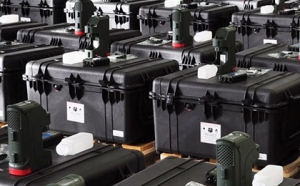BATTERIES ARE CONSIDERED THE SINGLE MOST IMPORTANT MAINTENANCE ITEM IN A UPS AND THE BIGGEST CONCERN OF LOGISTICS AND SUPPLY CHAIN MANAGEMENT.
Batteries are considered a consumable, much like the brakes on your car or the fuel in your gas tank. Over time batteries lose their ability to take a full charge, and therefore, typically every 2-5 years depending on the battery type and quality, the battery pack inside of a UPS should be replaced.
The battery chemistry considered standard in the UPS market is the rechargeable, non-hazardous, and non-spillable Sealed-Lead Acid (SLA) type, specifically the Valve-Regulated Lead Acid (VRLA), Absorbed Glass Mat (AGM) type. This is due to the chemistry’s ability to support high-discharge applications while offering a long-term storage life, both standard requirements of UPS applications. The compromise of using the SLA chemistry is that the battery is bulky and heavy due primarily to its low energy-density. While nearly every type of rechargeable battery offers a higher energy-density, none offers the long-term reliability or safety of the VRLA/SLA chemistry.
Additional Battery information includes:

The downside to this ability to sit relatively inactive for years and then immediately provide 100% performance is a relatively low energy density, meaning the batteries are bulkier and heavier than other battery chemistries. Also, care should be taken not to exceed the manufacturer’s recommend charge rate, meaning it can take up to 6-12 hours to recharge an SLA battery, regardless of capacity. Expedited recharge rates can harm an SLA battery. These considerations, while sometimes frustrating, have been accepted by the UPS market for decades.
- To act as a power conditioner, and
- To provide battery backup in the event of a power loss.
If the UPS malfunctions by way of the circuit board, it is seen as a failure of the entire UPS and therefore the vendor providing and supporting the UPS. Similarly, if the battery pack does not perform to the runtime and lifetime specifications that the design engineers specify (and that the end users expect), it is seen as a failure of the entire UPS. Therefore, we work hard to ensure that the batteries installed in all of our UPSs meet the quality requirements of our customers, because the batteries are as important a component in our UPS as the circuit board.
To meet the runtime and lifetime requirements as defined by our customers, a factory-supplied battery pack undergoes performance-based quality testing prior to final assembly. These processes then make factory-supplied battery packs superior to other identical-looking battery packs in both individual runtime and product life. This testing unfortunately takes a lot of time and is considered labor-intensive.
Most of our UPSs are designed to provide at least 4 minutes of battery backup runtime at 100% load. Not all systems are designed to run the UPS at 100% load, so your runtime will vary depending on battery capacitance and wattage draw. Where your load cannot be supported only by the battery pack in our UPSs, we offer additional battery backup trays which house additional battery packs and plug into the back of our UPSs.
Regarding charge time, most SLA battery manufacturers recommend charging their batteries at a fixed charge rate ratio regardless of capacitance. The charge current varies depending on capacitance, but the ratio of charge current to capacitance is always the same. This means that no matter the capacitance of the battery pack, large or small, the maximum amount of time required to take to charge your SLA battery pack is always going to be a conservative 6-12 hours.
There are varying opinions, but most SLA chargers follow a two-stage charging algorithm following by float charge. The last 10% of capacitance is the hardest to put back into the battery, meaning the first 90% of the charge cycle can take as long as the last 10% does.
For additional questions, including more detailed explanations and information, please contact:
- Sales & Customer Assistance- Product Questions, Quotes
- Technical Service & Support– RMAs, Repairs, Service Inquiries






